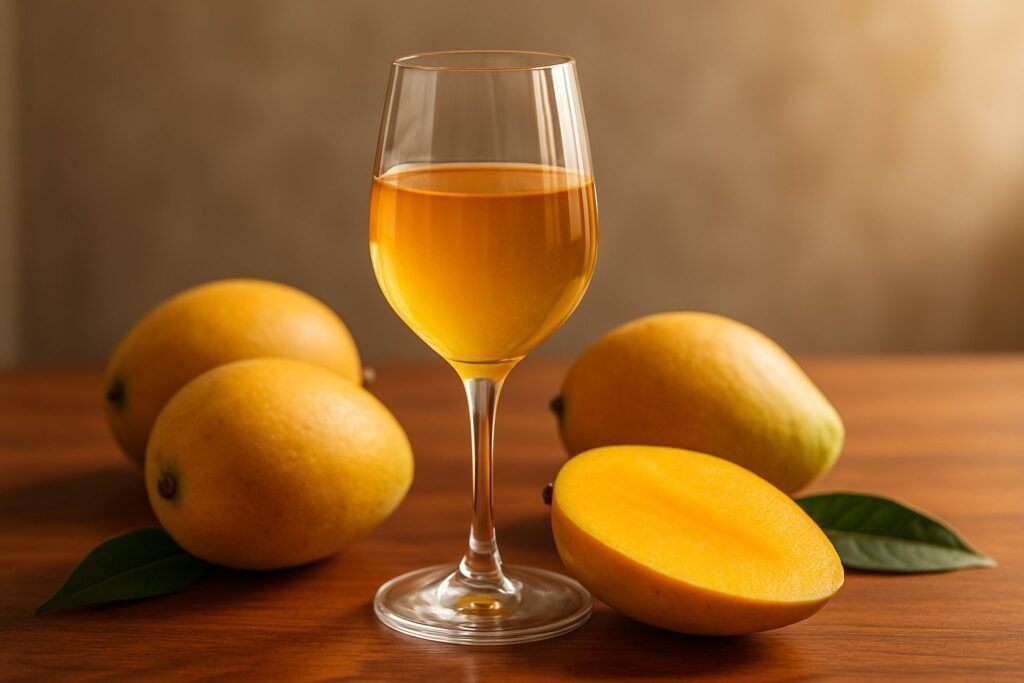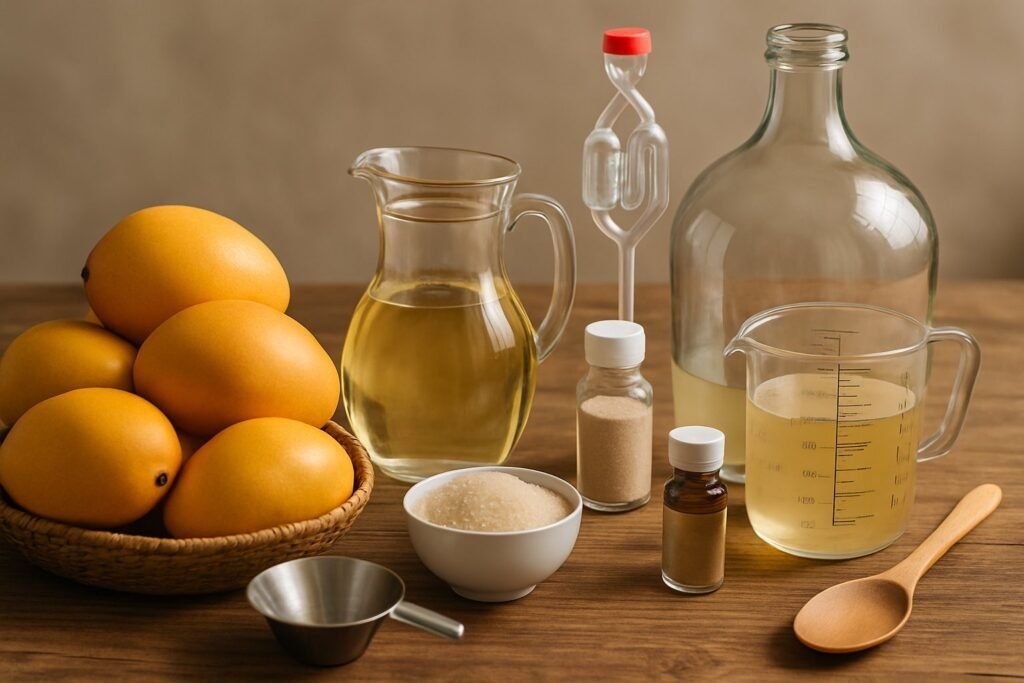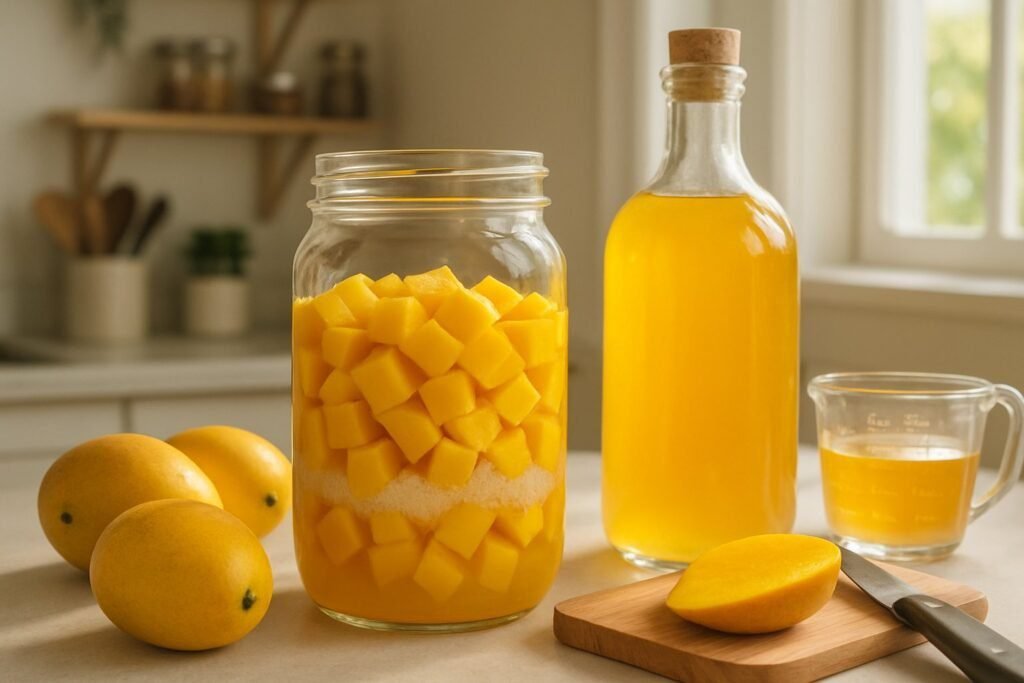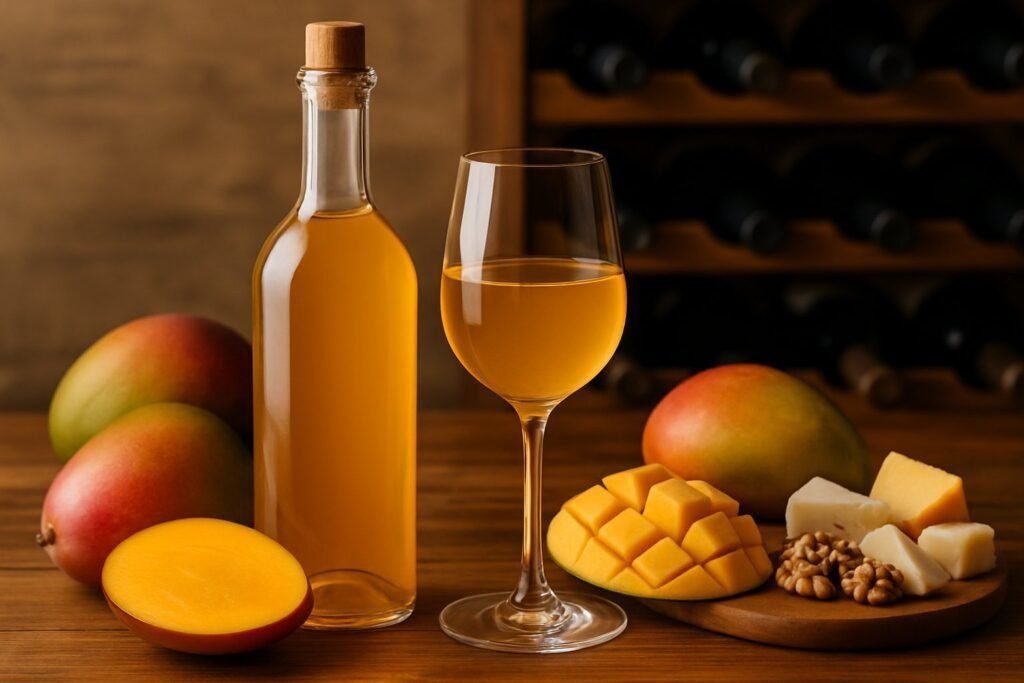This post may contain affiliate links. Please read my disclosure policy.
Ever wondered what happens when you swap grapes for mangoes in your wine glass? You get a tropical twist that’s as cheeky as it is refreshing. Mango wine is a fruity, lightly sweet drink made by fermenting ripe mangoes, offering a unique alternative to traditional grape wines.

You don’t need to be a sommelier to enjoy it either. Whether you’re sipping a chilled glass of sparkling mango wine from Mareeba or pairing a still variety with seafood, you’ll find it fits right into your table without fuss. Think of it as the laid-back cousin of Chardonnay, but with a sunnier personality.
If you’ve ever thought about making your own, you’ll be surprised at how simple it can be. With just mangoes, sugar, yeast, and a bit of patience, you can turn Australia’s favourite summer fruit into a bottle worth showing off. And if you’d rather buy than brew, local wineries have already done the hard work for you.
Key Takeaways
- Mango wine offers a tropical twist on traditional wine
- You can make it at home with simple ingredients and tools
- It pairs well with meals and keeps best when stored properly
What Is Mango Wine?
Mango wine takes the tropical sweetness of ripe mangoes and turns it into a light, fruity drink that’s both refreshing and slightly cheeky. It sits somewhere between a fruit juice that’s grown up and a wine that’s decided to wear a Hawaiian shirt.
Origins and Popularity
You might think mango wine was invented by someone who ran out of grapes, but it actually has deeper roots. In parts of India and Southeast Asia, people have been fermenting mangoes for centuries. These regions treated mangoes like royalty, so of course they found a way to turn them into alcohol.
Today, you’ll also see mango wine popping up in places like Queensland, where ripe mangoes are everywhere during summer. Winemakers there have figured out how to bottle that tropical vibe with a little Aussie flair.
It’s not just a local novelty either. Mango wine is gaining popularity worldwide as more people look for alternatives to traditional grape wines. Think of it as the fun cousin at the family BBQ—less serious, more fruity, and always welcome.
Unique Flavour Profile
When you sip mango wine, you’ll notice it doesn’t try to be something it’s not. It’s unapologetically tropical. Expect natural sweetness from ripe mangoes, balanced by a bit of acidity so it doesn’t taste like cordial.
The colour ranges from pale yellow to golden orange, depending on the variety of mango used. The aroma is fruity and floral, like someone shoved a mango tree into your glass.
Pairing is where it shines. Spicy Thai curries, seafood, or even pavlova go beautifully with mango wine. It’s not a wine that asks you to swirl and sniff for ten minutes—it just wants you to drink it and smile.
Types of Mango Wine
Not all mango wines are created equal. Some are made from fresh juice, while others use mango pulp. Both give you that fruity punch, but the pulp-based versions often taste richer and more full-bodied.
You’ll also find differences in sweetness. Some winemakers keep it semi-sweet, while others push for a dry style that surprises you with less sugar and more tang.
In Australia, you’ll spot small producers experimenting with varietals like Kensington Pride and R2E2 mangoes. These local heroes give each bottle a distinct flavour, proving mango wine isn’t just a gimmick—it’s a proper tropical contender.
For more detail on how it’s crafted, check out this guide on what mango wine is.
Essential Ingredients and Equipment

Making mango wine at home isn’t rocket science, but it does need the right fruit, a few specific additives, and some clean gear. If you skip any of these, you’ll end up with a funky science experiment instead of something you’d actually pour into a glass.
Choosing the Best Mangoes
You can’t make good mango wine with sad, stringy fruit that looks like it’s been through a rugby match. Pick ripe mangoes that feel soft when pressed and smell sweet at the stem. If they smell like cardboard, put them back.
Australian Kensington Pride mangoes are a great choice. They’re juicy, aromatic, and have enough sugar to keep the yeast happy. Avoid overripe mangoes with black spots, as they’ll add off flavours.
Peel the fruit and remove the seed before mashing it. A potato masher works fine, unless you secretly own a medieval torture device for fruit. The goal is a smooth pulp that will release juice easily during fermentation.
Key Ingredients for Mango Wine
Aside from mangoes, you’ll need a few extras to keep the yeast from giving up halfway. The basics are:
- Sugar – boosts alcohol levels and balances acidity.
- Wine yeast – a packet of Lalvin EC-1118 or similar will do the job.
- Yeast nutrient – think of it as a multivitamin for yeast, so it doesn’t faint mid-fermentation.
- Water – filtered or boiled and cooled, so you don’t add mystery microbes.
- Campden tablet – helps sterilise the must before yeast joins the party.
If you’re feeling fancy, you can blend in a splash of pineapple juice for a tropical twist. But keep it simple for your first batch, or you’ll be explaining to friends why your “wine” tastes like fruit salad gone wrong.
Must-Have Winemaking Tools
You don’t need a winery in the Barossa Valley to make mango wine, but you do need clean gear. Start with a fermentation vessel like a sanitised bucket with a lid. Later, you’ll transfer the wine into a glass carboy or demijohn for secondary fermentation.
An airlock is non-negotiable. It lets gas escape without letting in air (or curious insects). A siphon makes moving liquid from one vessel to another easy, without stirring up the sediment.
Other handy tools include a funnel, bottles, and corks. If you want to feel like a pro, grab a hydrometer to measure sugar levels. Otherwise, just trust your nose, your tastebuds, and possibly a mate who isn’t afraid to tell you the truth.
For a detailed breakdown of ingredients and tools, you can check the guide on mango wine preparation.
How to Make Mango Wine at Home

You’ll need ripe mangoes, clean equipment, and a bit of patience to turn fruit into wine. The process involves preparing the pulp, letting yeast work its magic during fermentation, and then carefully transferring and bottling your creation so it clears and develops flavour.
Preparation and Juicing
Start by scrubbing your winemaking gear like you’re prepping for a hospital inspection. A clean fermentation vessel keeps unwanted microbes from gate-crashing your mango wine party. Hot water or a mild bleach solution works fine—just don’t use soap unless you enjoy soapy undertones in your vintage.
For the fruit, scoop out the mango flesh or buy pulp if you’re lazy (no judgement). Aim for about 2 kilograms of pulp per 5 litres of wine. Pour boiling water over the pulp to release flavour and soften the fruit.
Once cooled, stir in pectinase to help break down the fruit. This step makes your wine clearer and less like a tropical smoothie. Cover the mix and let it sit for a day before adding sugar, which will feed the yeast later.
Fermentation Process
Now the fun begins. Dissolve wine yeast, like Lalvin EC-1118, in a bit of water and stir it into the pulp mixture. Yeast nutrient is also handy here—think of it as a vitamin supplement for your yeast so it doesn’t give up halfway through.
Pour everything into your fermentation vessel, cover it with an airlock or secured cloth, and keep it in a warm spot around 18–20°C. Stir daily for the first week while it bubbles away like a science experiment gone right.
The must (that’s the fancy word for your mango mash) will froth and fizz as the yeast converts sugar into alcohol. This stage can last weeks or even months, so resist the urge to sample too early unless you enjoy drinking cloudy fruit soup.
Racking and Bottling
When the bubbling slows down, it’s time for racking. Use a siphon to transfer the liquid into a clean vessel, leaving the sediment behind. This step clears the wine and gives it a more professional look—because no one brags about murky wine.
Add more dissolved sugar in stages if you want a sweeter style, then let it ferment again until activity stops. Repeat racking every few months until the wine looks clear.
Once satisfied, siphon into bottles, leaving a bit of space at the top. Cork them, stash them somewhere cool, and let the mango wine age for at least six months. If you’re feeling fancy, serve it alongside a crisp Australian Chardonnay to compare tropical notes—you’ll look like a true winemaker, even if you’re just winging it.
For step-by-step instructions with ingredient amounts, check out this detailed mango wine recipe.
Serving, Pairing, and Storing Mango Wine

Mango wine works best when you treat it like a proper table wine rather than a novelty drink. The way you pour it, match it with food, and keep it in the cupboard (or fridge) makes the difference between “wow” and “why did I open that?”.
Best Serving Suggestions
You should serve mango wine chilled, but not ice-cold. Around 8–10°C is the sweet spot. Too warm and it feels heavy, too cold and you’ll mute the fruit flavours.
Use a standard white wine glass so the tropical aromas have room to show off. If you’re feeling fancy, swirl it gently—just don’t overdo it or you’ll look like you’re auditioning for a wine commercial.
This wine shines as a summer refresher. Pour it straight from the fridge on a hot day and it behaves like the tropical cousin of a crisp Sauvignon Blanc. If you want to get creative, try it as the base for a light spritzer with soda water and a slice of lime.
Food Pairings
Mango wine loves company, but not every dish gets along with it. Dry styles pair well with seafood like prawns, barramundi, and oysters thanks to their delicate flavours and natural saltiness. A tropical salad with avocado and greens also works beautifully.
If you’re drinking a sweeter mango wine, go for spicy food. Think Thai curries or chilli prawns. The sweetness balances the heat without making your tongue feel like it’s on fire.
For cheeses, stick to the softer side. Brie or young goat’s cheese keeps the wine in the spotlight. Hard, sharp cheeses tend to bully the mango notes, and no one wants a pushy cheddar ruining the party.
You can even take inspiration from Shannonvale Tropical Fruit Winery, where locals pair mango wine with fresh fish and tropical fruit platters for a very Far North Queensland vibe.
Storing and Ageing
Mango wine’s not really built for the long haul like a bold Shiraz. Most bottles taste best within a year or two—let’s be honest, if you find one lurking at the back of the cupboard after five years, that’s probably just forgetfulness.
Stick your bottles somewhere cool and dark. If there’s a cork, lay it down; screw cap, just stand it up. The kitchen bench? That’s just asking for disappointment—unless you like your wine pre-cooked.
Once you crack it open, stash it in the fridge and drink up within a few days—three to five, tops. Sweet mango wines can hang on a bit longer, but the dry ones get tired fast. This isn’t one of those wines you squirrel away for a decade; it’s more of a “why not tonight?” sort of thing.
Frequently Asked Questions
Mango wine gets people talking: is it just a summer fling, does it work with seafood, where do you even buy it, and are Aussies really treating it like the next boxed wine?
Is duckstein mango wine the quack or just a fad?
So, is duckstein mango wine legit or just a cheeky gimmick with a wacky name? Honestly, it’s fruity and tropical, and it lands somewhere between a fun experiment and a proper drop. Give it a go before you write it off, life’s too short to skip the weird stuff.
Where can one snag a bottle of Katlenburger mango wine in Perth without doing a walkabout?
Hunting for Katlenburger mango wine in Perth? You don’t need to bush-bash for it. Big bottle shops and plenty of online stores usually stock it, so you can just order from the couch. Just hope the delivery guy doesn’t leave it to bake on your doorstep.
Can I throw a shrimp on the barbie with a glass of sparkling mango wine, or is that a recipe for disaster?
Yep, sparkling mango wine and prawns off the barbie actually work pretty well together. The tropical sweetness cuts through that smoky, seafood vibe. It’s kind of like pouring a chilled Verdelho with your grilled feast, just with more mango attitude.
How do you tell if your mango wine has gone off, or if it’s just got that tropical tang?
Fresh mango wine should smell fruity and taste bright. If you pop a bottle and it’s sour, flat, or weirdly fizzy (when it’s not meant to be), it’s probably gone off. Trust your senses, if it smells like vinegar or wet cardboard, it’s time to say goodbye.
What’s the go with mango wine in Cairns – is it the new goon bag?
Up in Cairns, mango wine’s become a fun twist on the usual cask wine scene. It’s not exactly the new goon bag, but locals seem to love the tropical vibe. You’ll spot it at barbies with reef fish more often than squeezed out of a silver sack. Buy from selected BWS stores or direct from Golden Drop Wines.
User Review
( votes)Sip smarter, subscribe now!
Subscribe for gourmet tips, event updates, travel ideas, and a free e-book on Food Pairings. Start your journey to culinary and travel excellence!












